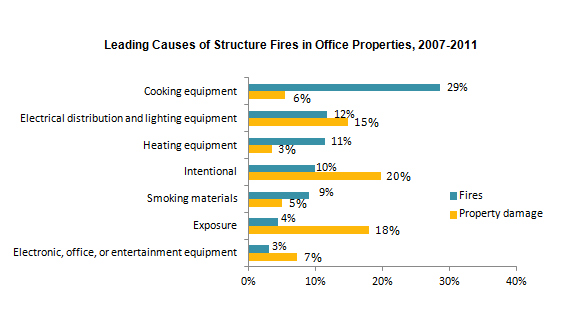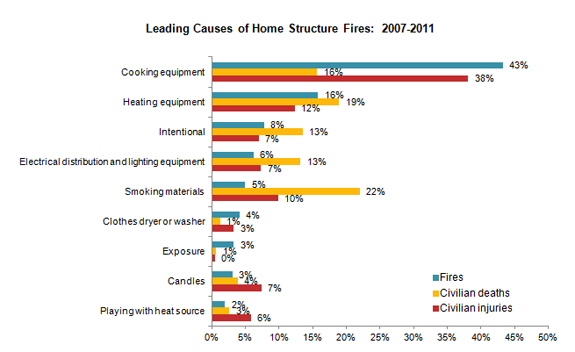Fire Safety
 |
||||||||||||
|
Last year there were over 1.2 million fires reported in the United States; resulting in over 3,000 civilian deaths, 15,000 civilian injuries and over $11.5 billion in property damage. The good news is that these deaths and other losses are preventable. In order to prevent potentially devestating fires, we all must take proper precautions to prevent potentially devestating fires. With proper planning, education, training and equipment you have the ability to:
We will cover the common causes of household and business fires, as well as ways you can prepare for and prevent fires. |
||||||||||||
 |
||||||||||||
|
Image Courtesy www.nfpa.org |
||||||||||||
|
There is, unfortunately, a long and tragic history of workplace fires that are completely preventable. Calolympic has not been immune to such tragedies: in 1963 a fire ravaged the Calolympic warehouse, destroying all in its path. Employees have a right to work in a safe workplace. To ensure proper fire prevention precautions and safety plans are being implemented, the Occupational Safety & Health Administration (OSHA) conducts fire safety inspections. As we can see from the graph, cooking equipment is the number one cause of business structure fires. Understanding common causes of office structure fires is an important step in identifying potential hazards, reducing or eliminating those hazards, and taking steps to ensure continued safety. It is every business' responsibility to have a fire prevention plan. |
||||||||||||
|
Business Fire Prevention To reduce fire-related accidents in the workplace, employers should:
|
||||||||||||
|
|
||||||||||||
|
Image Courtesy www.nfpa.org |
||||||||||||
|
You can expect to average a fire in your home every 15 years, or, five fires in an average lifetime (nfpa.org). Even the smallest fire needs to be handled effectively and quickly to ensure the least amount of damage possible. It is every homeowner's responsibility to educate themselves and their family on fire prevention. There are countless resources available that provide step-by-step instructions on what to do to prevent and prepare for a fire. As with business, the leading cause of household fires is cooking equipment. The best way to protect yourself and your home is to identify and remove these fire hazards. A practiced fire escape plan, along with a working smoke alarm, can save you and your family's lives. In fact, having a working smoke alarm reduces one's changes of dying in a fire by nearly half. |
||||||||||||
|
Household Fire Prevention To reduce fire hazards and prepare for fires, every home should:
|
||||||||||||
 |
||||||||||||
| Calolympic carries the safety equipment and training courses you need to protect your home and business. Don't see what you're looking for? Give us a call at 800.421.6630 and our friendly, knowledgeable customer service staff will promptly assist you. | ||||||||||||
|
|
||||||||||||
|
Additional Resources
|
||||||||||||
| The following links will take you away from Calolympic's website. Be sure to bookmark the Calolympic site so that, when you're done exploring the additional resources available, you can come back to the Calolympic page to stock up on what you need for your fire safety and prevention in your business or home. | ||||||||||||




